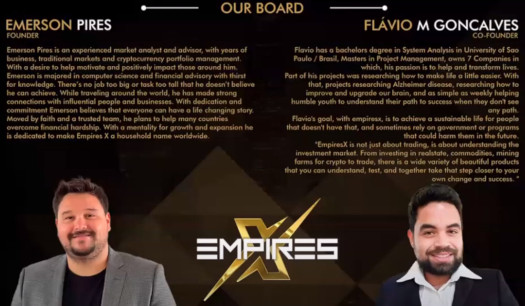SEC sues Mining Capital Coin’s Jr. Caputti & Emerson Pires
 Mining Capital Coin co-founders Luiz Carlos Capuci and Emerson Sousa Pires have been sued by the SEC.
Mining Capital Coin co-founders Luiz Carlos Capuci and Emerson Sousa Pires have been sued by the SEC.
The SEC alleges Capuci and Pires offered an “irresistible investment opportunity”, but in reality ran a Ponzi scheme.
I don’t know if this is some new policy or what but the SEC’s Mining Capital Coin complaint is deliciously snarky.
In the interests of efficiency (and totally nothing to do with me not being able to put it better myself), here’s the SEC breaking down Mining Capital Coin’s Ponzi;
Defendant MCC International Corp. or “MCC” and its founders, defendants Luiz Carlos Capuci, Jr. and Emerson Sousa Pires, offered investors an irresistible opportunity.
MCC crowed about its thousands of machines, here and abroad, that actively mined for cryptocurrency, like Bitcoin.
It boasted about its team of traders and phalanx of trading robots, who relentlessly found and exploited arbitrage opportunities in the stock, foreign exchange, and crypto markets.
It touted how, by planning to mine for gold in Africa and to drill for oil in Canada, it would be diversifying its portfolio while hedging its bets. All of which made MCC a most impressive company.
But what made it an irresistible investment opportunity was its guaranteed returns:
An eye-popping 1 % daily “profit sharing” return, paid weekly. So just one week after an investor made her $10,000 investment, MCC would pay her $700.
A week later, another $700. And so on. So that by the time her membership expired a year later, her initial $10,000 investment would have ballooned to $36,400 – a guaranteed annual return of 364%.
Better still, MCC allowed an investor to easily tap into her returns.
Each week she could make a request to liquidate her $700 weekly returns. So after 15 weeks, she could recoup her $10,000 initial investment (and then some).
And then she still could look forward to 37 more guaranteed installments of $700 coming her way, which she could easily liquidate to use as she saw fit. All thanks to MCC’s profitable mining and trading operations.
But wait – there was more. Rather than take her profit-sharing returns in Bitcoin, MCC offered her a once-in-a-lifetime opportunity to get in on the ground floor of its very own newly minted Capital Coin tokens (“CPTL”).
If Bitcoin was any guide – and really, why wouldn’t it be? – if she invested her $36,400 in the still nascent CPTL, there was no limit to the wealth she could amass once the currency caught on.
As it turned out, an investor could check out of MCC anytime she liked, but her money could never leave. Once she entrusted her hard-earned savings to MCC, defendants put up roadblock after roadblock to prevent her from cashing out.
Worse, they shook her down for still more money – in the form of new transaction fees and renewals – if she ever hoped to see her money again.
MCC was a Potemkin village for the digital age. There was no mining for cryptocurrency. No trading robots. No trading.
MCC might have created its own crypto asset, but it had no real value.
MCC had one, and only one, source of revenues: Its unsuspecting investors.
Whereas the DOJ has pegged Mining Capital Coin losses at around $62 million, the SEC, whilst acknowledging actual losses are “likely much, much more”, have shrunk it down to $8 million.
Tens of thousands of investors in the United States and abroad lined up to invest in MCC.
Defendants took in at the very least $8 million in investor proceeds, although their true haul was likely much, much more.
The total number of Mining Capital Coin investor accounts has been pegged at 65,535.
While I couldn’t have known how much was being stolen, BehindMLM reviewed Mining Capital Coin in mid 2018.
Not surprisingly, I came to the same conclusion as the SEC.
One aspect of Mining Capital Coin that occured after publication of BehindMLM’s review was the Capital Coin (CPTL) exit-scam.
In particular, how CPTL was marketed;
Defendants made many representations to MCC investors about the new CPTL:
• There would be a limited supply;• MCC had applied to list CPTL on an established crypto asset exchange platform;
• That exchange would list CPTL on its platform no later than July 1, 2021 ;
• MCC had completed construction of a e-commerce mall that would accept CPTL in exchange for goods;
• MCC had made arrangements with major hotels and casinos to accept CPTL for payment; and
• The MCC Pay application – which, investors were told, was like “Apple Pay,” only with CPTL – was already up-and-running in Asia, and was pending authorization in the United States.
CPTL’s marketing promises read like any MLM crypto Ponzi token exit-scam.
While Mining Capital Coin and CPTL are long gone, the same ruses are being trotted out today by other MLM crypto Ponzis.
When MCC members tried to sell CPTL on Bitchain before their one-year membership expired, they immediately encountered a litany of errors that stymied their efforts to liquidate their MCC investments.
MCC investors thus faced an unfortunate choice: Either double-down on their initial MCC investment by buying another mining package or walk away from their MCC investment, along with any hope of recovery.
Capuci blamed Bitchain for these problems. Such blame can charitably be described as disingenuous, since as it turns out, Capuci was Bitchain.
As the months dragged on and withdrawal excuses began piling up…
Bitchain for last 20 days was a little bit slow with transfer and withdrawals; the reason was they were creating [application programming interfaces].
…Capuci dragged COVID-19 into his drawn out exit-scam;
When defendants weren’t making excuses for Bitchain or blaming it, they were blaming the pandemic for the delays. Bitchain joined in, publishing a “Bitchain COVID 19 Notice” on its website that attributed delays to the virus.
Despite assuring investors that “CPTL’s market value would increase ten-fold in a single year”, the exit-scam continued to drag on.
 Capuci (right) would go on to tell investors he’d “worked for the FBI for almost eight years”. That of course wasn’t true.
Capuci (right) would go on to tell investors he’d “worked for the FBI for almost eight years”. That of course wasn’t true.
Legitimacy via association also became part of Mining Capital Coin’s marketing. Partnerships with the Clinton Foundation and World Bank were claimed, neither of which existed.
Named defendants in the SEC’s lawsuit are
- MCC International Corp, dba Mining Capital Coin Corp
- CPTLCoin Corp.
- Bitchain Exchanges
- Luiz Carlos Capuci, Jr.
- Emerson Sousa Pires
Capuci and Pires are dual Brazilian US nationals residing in Florida.
When questioned about MCC’s use of mining machines during testimonies taken by the SEC in 2021 and 2022, Capuci and Pires both invoked their Fifth Amendment privilege against self-incrimination.
In earlier SEC testimony in 2020, they had testified that MCC had some mining machines in the United States but “never used them” because one mining machine alone “uses more electricity than the whole building.”
MCC has admitted to the SEC that it never had trading robots and never engaged in any trading.
When the SEC questioned Capuci and Pires about MCC’s trading platform, they invoked their Fifth Amendment rights against self-incrimination.
After their last 2022 testimonies were taken, both Capuci and Pires fled to Brazil.
Defendants have misappropriated much of these proceeds. Capuci and Pires have paid themselves generous salaries, ranging from $5,000 to $20,000 a month in Bitcoin each.
Further, at a time when MCC was Capuci’s only source of income, he spent millions to fund a lavish lifestyle.
He bought two Ferraris, a Lamborghini, a Mercedes, a yacht, and real estate, among other extravagant purchases.

Pires, for his part, has spent about $10.9 million during the relevant period, some of which he used to buy real estate, a Mercedes, a Harley Davidson, a Land Rover, and a Lamborghini.
Across four counts, the SEC have sued the Mining Capital Coin defendants for
- violations of the Securities Act (all defendants)
- violations of the Exchange Act (all defendants) and
- control person liability (Capuci and Pires)
The SEC is seeking a permanent injunction, disgorgement of ill-gotten gains and a civil penalty.
Capuci has been separately indicted on related criminal charges. Whether Emerson Pires will face criminal charges remains to be seen.
After Mining Capital Coin Pires continued to defraud consumers through EmpiresX, another MLM crypto Ponzi.

The SEC’s Mining Capital Coin complaint was filed on April 7th. It’s not showing up on Pacer yet so I’m assuming it was filed under seal.
I’ll check back on Monday for any docket updates.
Update 10th May 2022 – A TRO was granted against the Mining Capital Coin defendants in late April.
A preliminary injunction hearing has been scheduled for May 19th.
Update 30th August 2022 – A preliminary injunction was granted against Mining Capital Coin, Caputti and Pires on June 17th.
Update 5th September 2025 – The SEC has secured a $46.2 million default judgment against Mining Capital Coin co-founders Luiz Capuci and Emerson Pires.


Lulz, maybe the SEC have finally had enough of crypto fuckboys like the rest of us. Here’s to snarky filings being the new norm!
Also on a related note;
This Crypto Assets and Cyber Unit investigated and handled the MCC case. We’re probably in for larger servings of popcorn as the new staff are put to use.
sec.gov/news/press-release/2022-78
And they still won’t be able to keep up with our one-man army Oz, here!
Seriously, though, as I was reading through this article, it seemed like every SEC quote was backing up what Oz has said repeatedly in response to scammer and victim excuses: claims of miners, trades, legitimacy by association, they’re all here, and all shown to be a pack of lies.
I think the victims (the real ones who lose money in these scams) underestimate how easy it is for scammers to look you or the camera straight in the eye and shovel large amounts of bullshit.
Then the victims come here and demand proof that they’re being fed lies instead of demanding proof from the scammers that they’re not.
One thing I don’t have though is the DOJ backing me on investigations. If the SEC/DOJ combo ramps up, and they can close the gap (currently at what, ~4 years between launch and indictment),
Something also needs to be done about the YouTube problem. Upload some titties and the aLgOrItHm will nuke your video before it’s finished uploading.
People using YouTube to commit securities fraud and spawn their own army of Ponzi promoters? This is fine.